Editor’s note: This guest commentary is from Deron Lovaas, Co-Director, Energy Efficiency for All at the Natural Resources Defense Council, an Energy Foundation grantee. The original post can be found here.
By:Deron Lovaas
Huge numbers of Americans struggle and sacrifice to afford energy bills—a fact the majority understands and would even pay more to help rectify, a new poll shows. The poll, commissioned by Energy Efficiency for All, follows groundbreaking reports that found that on average low-income urban households pay more than twice as much in energy bills as a percentage of their income as others, with rural America taking an even bigger hit. According to the poll, 43 percent of people making less than $40,000 a year say they make sacrifices such as forgoing opportunities in education and healthcare so they can pay for energy. Only 14 percent of those making $100,000 or more do so. And almost one in five of the former report making a “serious sacrifice” while just 3 percent of the latter do. The poll also found that racial minorities and low-income renters are hit hardest by high utility bills. Three times as many African-Americans and twice as many Latinos report making serious sacrifices to afford their utility bills compared to non-minority households. Likewise, low-income renters with incomes less than $40,000 a year report making serious sacrifices at higher rates compared to all other homeowners and renters.


The poll results are consistent with findings from research on the prevalence of high energy burdens conducted by EEFA and the American Council for an Energy Efficient Economy (ACEEE). It makes intuitive sense that lower-income Americans would use more of their paychecks to pay for energy, giving them a greater “energy burden,” but what the reports also found is that people with limited income have a bigger burden because they often are not able to take advantage of energy-saving appliances, windows, lightbulbs and weather stripping, and they tend to live in older homes, apartments and manufactured housing that waste energy. The reports discovered, for example, that if low-income housing stock were brought up to the efficiency level of the average U.S. home, 35 percent of the average low-income energy burden of low-income households would be eliminated. For African-American and Latino households, 42 percent and 68 percent of the excess energy burden, respectively, would be gone. Closing that gap is important to the families involved, obviously, but it’s also important to all of us in terms of our health and well-being. Families who can reduce energy waste have more money left over to feed and educate their children, more to contribute to the economy, and they help reduce the burning of fossil fuels and improve the air we breathe. There are real people behind these numbers. Crystal Barbour, a mother from Charlottesville, Virginia, who was interviewed as part of EEFA’s research, says that she dreaded the monthly ritual of opening her utility bill. “You would eat cheap when it was electric bill week,” she said. Barbour’s story—like many others we have documented—greatly improved with energy-efficiency programs that helped her save money and better feed and clothe her children.
Our polling shows that most Americans favor such programs, favor utility companies’ efforts to offer them and are even willing to help pay for them. Out of 1,600 people questioned, the following proposals received majority support across demographic, generational, racial and regional lines:
- Requiring utility companies to provide financial incentives to help customers cover the cost of energy-saving improvements to their homes – 82 percent
- Requiring utility companies to provide financial incentives to help customers with limited incomes cover the cost of energy-saving improvements to their homes – 78 percent
- Requiring low-income rental homes to meet a minimum standard of energy and water efficiency – 75 percent
- Making sure renters are getting the same benefits as homeowners when it comes to energy-efficiency programs – 84 percent
- Helping low-income and working-class households make their homes more energy efficient, if it were paid for by adding 50 cents to every customer’s monthly electric bill – 58 percent
- Helping low-income and working-class households make their homes more energy efficient, paid for by adding $1 to every customer’s monthly electric bill – 52 percent
This polling shows that Americans agree with policy solutions that we know help relieve the unfair energy burden for millions of families, improving their chance to keep a roof over their heads, to thrive and to enjoy a healthy quality of life. Specifically, Energy Efficiency for All builds coalitions in 12 states and we value collaboration with new partners as a way to advocate for an array of policy solutions ranging from broad Energy Efficiency Resource Standards (EERS) that require a specific amount of energy savings via efficiency programs, such as the one in my home state of Maryland, to one-stop-shop resources for property owners and managers to tap into as our western director Maria Stamas describes here. To be honest, we thought the question on whether people would help others by their willingness to pay for these policy solutions would be an especially difficult one. But this new research shows an awareness that those among us with limited incomes are weighed down heavily by monthly utility bills and that there is solid support for measures that deliver relief as well as benefits for all of us.
